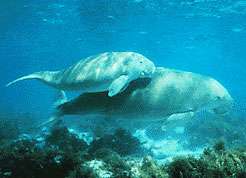List of mammals of Palau
This is a list of the mammal species recorded in Palau. There are fifteen mammal species in Palau, of which two are endangered, one is vulnerable, and one is considered to be extinct.[1]
The following tags are used to highlight each species' conservation status as assessed by the International Union for Conservation of Nature:
| EX | Extinct | No reasonable doubt that the last individual has died. |
| EW | Extinct in the wild | Known only to survive in captivity or as a naturalized populations well outside its previous range. |
| CR | Critically endangered | The species is in imminent risk of extinction in the wild. |
| EN | Endangered | The species is facing an extremely high risk of extinction in the wild. |
| VU | Vulnerable | The species is facing a high risk of extinction in the wild. |
| NT | Near threatened | The species does not meet any of the criteria that would categorise it as risking extinction but it is likely to do so in the future. |
| LC | Least concern | There are no current identifiable risks to the species. |
| DD | Data deficient | There is inadequate information to make an assessment of the risks to this species. |
Some species were assessed using an earlier set of criteria. Species assessed using this system have the following instead of near threatened and least concern categories:
| LR/cd | Lower risk/conservation dependent | Species which were the focus of conservation programmes and may have moved into a higher risk category if that programme was discontinued. |
| LR/nt | Lower risk/near threatened | Species which are close to being classified as vulnerable but are not the subject of conservation programmes. |
| LR/lc | Lower risk/least concern | Species for which there are no identifiable risks. |
Subclass: Theria
Infraclass: Eutheria
Order: Sirenia (manatees and dugongs)
Sirenia is an order of fully aquatic, herbivorous mammals that inhabit rivers, estuaries, coastal marine waters, swamps, and marine wetlands. All four species are endangered.
- Family: Dugongidae
Order: Primates
The order Primates contains humans and their closest relatives: lemurs, lorisoids, monkeys, and apes.
- Suborder: Haplorhini
- Infraorder: Simiiformes
- Parvorder: Catarrhini
- Superfamily: Cercopithecoidea
- Family: Cercopithecidae (Old World monkeys)
- Genus: Macaca
- Crab-eating macaque, Macaca fascicularis LR/nt
- Genus: Macaca
- Family: Cercopithecidae (Old World monkeys)
- Superfamily: Cercopithecoidea
- Parvorder: Catarrhini
- Infraorder: Simiiformes
Order: Chiroptera (bats)
The bats' most distinguishing feature is that their forelimbs are developed as wings, making them the only mammals capable of flight. Bat species account for about 20% of all mammals.
- Family: Pteropodidae (flying foxes, Old World fruit bats)
- Subfamily: Pteropodinae
- Genus: Pteropus
- Pelew flying fox, Pteropus pelewensis NT
- Large Palau flying fox, Pteropus pilosus EX
- Genus: Pteropus
- Subfamily: Pteropodinae
- Family: Emballonuridae
- Genus: Emballonura
- Polynesian sheath-tailed bat, Emballonura semicaudata EN
- Genus: Emballonura
Order: Cetacea (whales)
The order Cetacea includes whales, dolphins and porpoises. They are the mammals most fully adapted to aquatic life with a spindle-shaped nearly hairless body, protected by a thick layer of blubber, and forelimbs and tail modified to provide propulsion underwater.
- Suborder: Mysticeti
- Family: Balaenopteridae
- Subfamily: Balaenopterinae
- Genus: Balaenoptera
- Bryde's whale, Balaenoptera edeni DD[2]
- Genus: Balaenoptera
- Subfamily: Balaenopterinae
- Family: Balaenopteridae
- Suborder: Odontoceti
- Superfamily: Platanistoidea
- Family: Physeteridae
- Genus: Physeter
- Sperm whale, Physeter macrocephalus VU
- Genus: Physeter
- Family: Kogiidae
- Genus: Kogia
- Dwarf sperm whale, Kogia sima LR/lc
- Genus: Kogia
- Family: Ziphidae
- Subfamily: Hyperoodontinae
- Genus: Mesoplodon
- Blainville's beaked whale, Mesoplodon densirostris DD
- Ginkgo-toothed beaked whale, Mesoplodon ginkgodens DD
- Genus: Mesoplodon
- Subfamily: Hyperoodontinae
- Family: Delphinidae (marine dolphins)
- Genus: Stenella
- Spinner dolphin, Stenella longirostris LR/cd
- Genus: Lagenodelphis
- Fraser's dolphin, Lagenodelphis hosei DD
- Genus: Grampus
- Risso's dolphin, Grampus griseus DD
- Genus: Feresa
- Pygmy killer whale, Feresa attenuata DD
- Genus: Globicephala
- Pilot whale, Globicephala macrorhynchus LR/cd
- Genus: Stenella
- Family: Physeteridae
- Superfamily: Platanistoidea
See also
Notes
- This list is derived from the IUCN Red List which lists species of mammals and includes those mammals that have recently been classified as extinct (since 1500 AD). The taxonomy and naming of the individual species is based on those used in existing Wikipedia articles as of 21 May 2007 and supplemented by the common names and taxonomy from the IUCN, Smithsonian Institution, or University of Michigan where no Wikipedia article was available.
- "Archived copy" (PDF). Archived from the original (PDF) on 2016-03-04. Retrieved 2016-09-20.CS1 maint: archived copy as title (link)
References
- "The IUCN Red List of Threatened Species: Mammals of Palau". IUCN. 2001. Retrieved 22 May 2007.
- "Mammal Species of the World". Smithsonian National Museum of Natural History. 2005. Archived from the original on 27 April 2007. Retrieved 22 May 2007.
- "Animal Diversity Web". University of Michigan Museum of Zoology. 1995–2006. Retrieved 22 May 2007.

